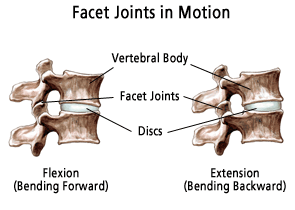Facet joints are spinal joints located from the cervical spine (neck) to the lumbosacral junction (tailbone). Each lumbar motion segment has two facet joints, one on the left and one on the right. A lumbar motion segment is simply the two vertebral bones and the intervertebral disc between them.
The facet joints are oriented in different planes depending on where they are along the spine.
The lumbar (lower back) facet joints are oriented in a sagittal plane. This allows the lumbar spine to flex and extend, primarily. There is a small amount of rotation and side bending present through the lumbar spine.
The thoracic (mid back) facets are oriented in more of a frontal plane. This orientation allows for more rotation compared to the lumbar spine. Flexion, extension, and side bending are present as well.
The cervical (neck) facets are oriented at around a forty-five degree angle from the frontal plane. This allows for a considerable amount of motion into flexion, extension, side bending, and rotation.
There is no specific time frame for how long facet joint injections last. There is not any clear evidence in the medical literature that facet joint injections are even effective. A recent review of the medical literature found no indication that facet joint injections are effective. The latest treatment guidelines recommend not doing facet joint injections because they are not effective. Despite the evidence of facet joint injections being ineffective, they do help some people. If the injections do reduce pain the relief may last weeks or months.
A corticosteroid is injected into the facet joint of the spine. The injection can be intra-articular (inside the joint) or extra-articular (outside of the joint, around the joint capsule).
Facet joints are spinal joints located from the cervical spine (neck) to the lumbosacral junction (tailbone). Each spinal motion segment has two facet joints, one on the left and one on the right. The facet joints are oriented in different planes depending on where they are along the spine. The lumbar facet joints are oriented in a sagittal plane. The thoracic (mid back) facets are oriented in more of a frontal plane. The cervical (neck) facets are oriented at around a forty-five degree angle from the frontal plane.
Facet joint arthropathy simply refers to age related changes of the cartilage and joint. Basically, facet joint arthropathy is another term for facet joint arthritis. Arthropathy or arthritis of the facet joint is no different compared arthritis of the hands, knees, or hips.



